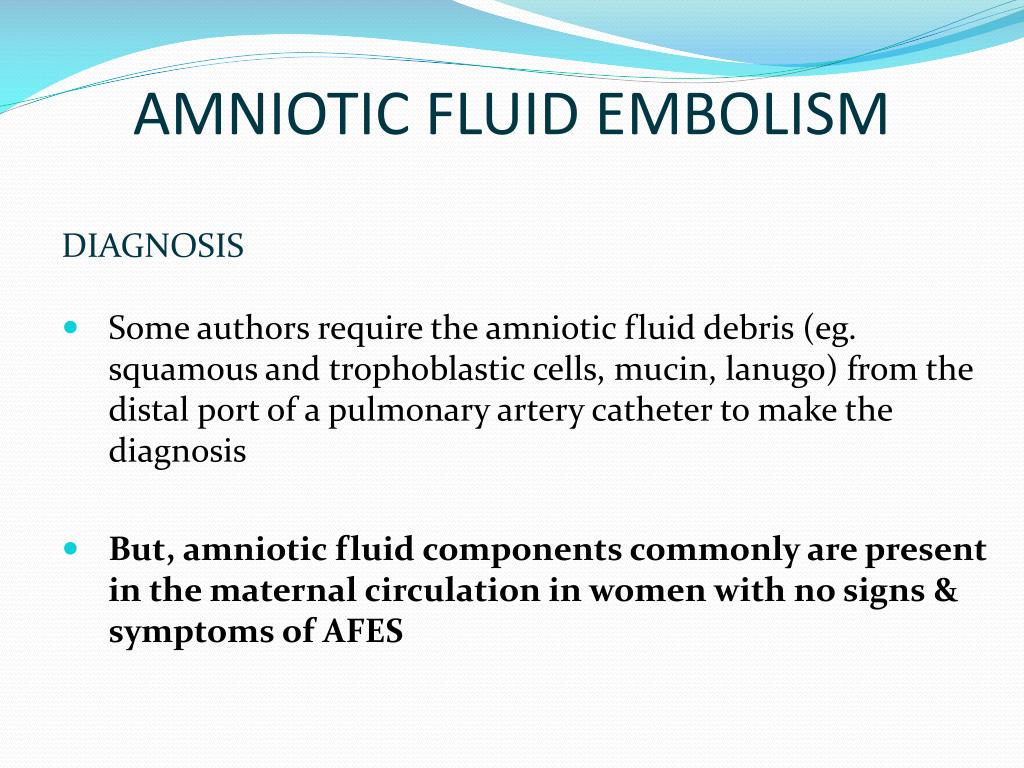
Delivery location (home, birth center, hospital).Variability of each women’s immune response.Survivability of an amniotic fluid embolism is dependent upon several factors and is therefore very difficult to provide an accurate rate.

It was once believed that an amniotic fluid embolism diagnosis could only be made through autopsy based solely on the presence of fetal material in the lungs or circulation, however, this is no longer a valid diagnostic criterion as many women will have the presence of fetal material in their circulation and not have experienced any of the symptoms of an amniotic fluid embolism. In fatal cases, an autopsy is highly recommended and will aid the team in ruling out any other potential causes. The health care team will review the case usually in a formal debrief and will look at the timing of symptoms and all laboratory tests and imaging to rule out any other possibilities. It may take several days, or in cases when the mother passes- months, for a diagnosis to be made. Unlike cancer or a broken bone, there is no blood test or imaging that can confirm the diagnosis of amniotic fluid embolism. There are approximately 700,000 deliveries in the UK each year, meaning approximately 13 women may experience an amniotic fluid embolism.Īmniotic fluid embolism remains a diagnosis of exclusion meaning all other possible clinical explanations for the symptoms have been ruled out.

Recent publications based on administrative data (data that has not had cases individually reviewed for accuracy) suggests that the estimated incidence of amniotic fluid embolism is 2.5 for every 100,000 births or 1 in 40,000 in the United States and 1 in 53,800 of the approximately in Europe.įor perspective, there are approximately 4 million deliveries in the United States meaning approximately 100 women may suffer an amniotic fluid embolism.

Therefore, the incidence of amniotic fluid embolism may be both over-reported and underreported. The statistics around the incidence of amniotic fluid embolism vary because the diagnosis of this syndrome remains one of exclusion and lacks any specific laboratory test or confirmation imaging, thus meaning that a diagnosis of amniotic fluid embolism is made after all other reasonable explanations have been ruled out. Treatment of hemorrhage and DIC include blood transfusions, surgical procedures, and medications to help control bleeding and replenish the body’s blood volume.Īdvances in critical care medicine offer more complex interventions, although not all hospitals have access to these types of treatments.Īmniotic fluid embolism is rare and a leading cause of maternal death globally. Excessive bleeding and clotting may lead to more serious complications including stroke, organ failure, and ultimately heart failure. This increased clotting quickly depletes the body’s platelets and clotting factors that are needed to control bleeding. DIC causes the over-development of blood clots throughout the bloodstream. This can lead to a condition known as disseminated intravascular coagulopathy (DIC). However, in women who experience an AFE, the blood’s normal balance (hemostasis) is interrupted by a complicated process causing sudden and excessive bleeding (hemorrhage). Treatment of heart and lung failure includes oxygenating the body by placing a breathing tube (intubation), cardiopulmonary resuscitation (CPR), and medications to help manage blood pressure and help the heart beat regularly.īleeding is a normal process of birth. Lack of oxygen to the body can cause organ failure and brain damage. When the heart stops beating it is no longer able to send oxygenated blood to the body. Heart and lung failure causes breathing problems, irregular heartbeat, seizures, and can lead to cardiac arrest- when the heart stops beating. Together, they are exceptionally challenging to treat and require immediate and aggressive medical care. Independently, each of these complications is extremely serious and life-threatening. Most often an AFE involves two very serious and life-threatening complications heart and lung failure (cardiorespiratory collapse) and severe bleeding (disseminated intravascular coagulopathy or DIC). It is important to note that the entrance of amniotic fluid and fetal material into the bloodstream is a normal part of the birth process and in most women, it does not cause this serious reaction.

It is believed to occur when a mother suffers an allergic-like (immune) response to amniotic fluid and fetal material that enters her bloodstream during labor or shortly after delivery. Although the exact mechanism of how an amniotic fluid embolism (AFE) occurs is not well understood.


 0 kommentar(er)
0 kommentar(er)
